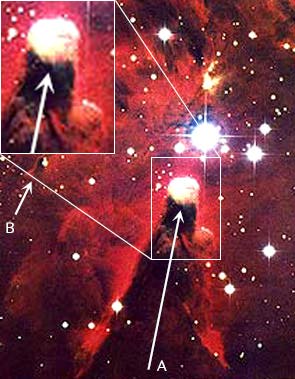The cone Nebula is a good example of a decaying ball-of-light. The image below -- before my changes -- was originally from the Anglo-Australian Observatory.
(Go to: http://www.ast.cam.ac.uk/AAO/local/www/dfm/image/aat013.jpg to see the original.)

Note how the stars have the cross-like diffraction spikes coming out of them. Note how the tip of the Cone at "A" is fuzzy looking and has no diffraction spikes. This is not a star. It is a rapidly decaying ball-of-light. (I would not be surprised if the core of the tip explodes in a supernova.) As it is decaying, it is leaving behind a trail of gas and dust that is shaped like a cone. The tip of the cone is highly ionized because the core ball-of-light is inducing new elementary particles -- just the nuclei -- and is giving off large amounts of high energy photons. Some of these photons will be absorbed by some of the small amount of atomic nuclei with orbiting electrons and re-emitted. Thus, the Ball-of-Light Particle Model predicts that this object at "A" will have high amounts of nonthermal radiation and unusual spectra for unusually large atomic nuclei -- possible elements might include: silicon, sulfur, and magnesium.
I would love to read about the spectral analysis of the tip of the cone at "A."
I would love to see the close-up details of this nebula from the Hubble Space Telescope! The would imagine that the cone -- especially in the area below the arrowhead -- is filled with smaller decaying balls-of-light that are similar to the trails in the Pillars of M16 and the "Twisters" in the Lagoon Nebula.
The Ball-of-Light Particle Model predicts an infrared image of this object at "A" will reveal a bright point-like source at its center. Around the center ball-of-light there may be more smaller balls-of-light.
In another location in the Cone Nebula, the Hubble Space Telescope used its new infrared NICMOS detector to image a hidden star. Around the star are located what are referred to as "Baby Stars."

The Ball-of-Light Particle Model predicts these baby stars may eventually cool into planets and orbit this star like the planets in our solar system. (See also, Planetary Formation, Example of an induced ball-of-light)
Again, as always, the Ball-of-Light Particle Model easily describes unusual objects in space as decaying balls-of-light. At the core of each object is a sphere of electric, magnetic, and gravitational fields -- a ball-of-light. On the surface of the core object are electromagnetic waves. The waves sweep over the core induces smaller balls-of-light. The pattern of the waves, the pattern of the harmonics, the strength of the waves all determine how large the induced particles are, and the pattern of how they are ejected. As always, the origin of the ball-of-light is a larger ball-of-light -- going all of the way back to the Big Bang where a ball-of-light that included all of the energy of the universe decayed!
Note that there is a second, smaller cone at "B" on the left side of the image.